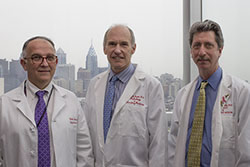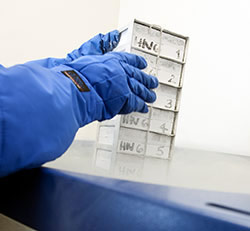
|
Genetic Modification of Cells Proves Generally Safe as HIV Treatment Strategy
NIH-Supported Technique Might Help Achieve Drug-Free Control of HIV
March 5, 2014
 WHAT: WHAT:
Scientists today report initial results from humans on the safety and tolerability of a novel strategy to curb HIV
disease by removing key cells from HIV-infected individuals, genetically modifying the cells to resist HIV infection and
returning them to those individuals. The basic and pre-clinical research on this strategy, which eventually might help
people control the virus without drugs, was funded by the National Institute of Allergy and Infectious Diseases
(NIAID), part of the National Institutes of Health. The Phase I clinical trial was funded by Sangamo
BioSciences and was led by NIAID grantee Carl H. June, M.D., with co-investigators
Bruce L. Levine, Ph.D., and Pablo Tebas, M.D., all of the Perelman School of
Medicine at the University of Pennsylvania, Philadelphia.
The trial built on the observation that people who naturally have a genetic modification in a protein called CCR5 are resistant
to HIV infection, and when infected with HIV, progress to AIDS more slowly. CCR5 is a cell-surface molecule, or receptor, that
most HIV variants must use to enter their primary target: the CD4+ T cell. In the trial, CD4+ T-cells were collected from 12
HIV-infected volunteers whose virus was controlled by anti-HIV therapy. These cells were then treated in the laboratory
with molecular tools called zinc-finger nucleases (ZFNs). The ZFNs were designed to snip the DNA within the gene that
codes for the CCR5 receptor. This process introduced a genetic mutation rendering CCR5 receptors non-functional.
Subsequently, the cells were stimulated to multiply, and each patient received an infusion of 10 billion of
their own CD4+ T-cells, with roughly a fifth of the CCR5 genes now mutated.
 Four weeks later,
in a planned interruption of anti-HIV therapy, half the study participants stopped taking their antiretroviral drugs for 8 to 12
weeks. Investigators found that the experimental treatment was generally safe, and that the genetically modified cells appeared
to be protected from HIV infection. In one volunteer who naturally had the desired mutation in half of his CCR5 genes, the
virus became undetectable in his blood during the 12-week treatment interruption. Future research will include
evaluating this experimental treatment in more volunteers, as well as maximizing the frequency of CCR5
disruption by ZFNs and increasing the persistence of the genetically modified cells in the body to
achieve a therapeutic effect. Four weeks later,
in a planned interruption of anti-HIV therapy, half the study participants stopped taking their antiretroviral drugs for 8 to 12
weeks. Investigators found that the experimental treatment was generally safe, and that the genetically modified cells appeared
to be protected from HIV infection. In one volunteer who naturally had the desired mutation in half of his CCR5 genes, the
virus became undetectable in his blood during the 12-week treatment interruption. Future research will include
evaluating this experimental treatment in more volunteers, as well as maximizing the frequency of CCR5
disruption by ZFNs and increasing the persistence of the genetically modified cells in the body to
achieve a therapeutic effect.
ARTICLE:
P Tebas et al. Gene editing of CCR5 in autologous CD4 T-cells of persons infected with HIV. The New England Journal of Medicine DOI: 10.1056/NEJMoa1300662
(2014).
WHO:
NIAID Director Anthony S. Fauci, M.D., is available for comment.
CONTACT:
To schedule interviews, please contact Laura S. Leifman, (301) 402-1663.
###
NIAID conducts and supports research—at NIH, throughout the United States, and worldwide—to study the causes of infectious and immune-mediated diseases, and to develop better means of preventing, diagnosing and treating these illnesses. News releases, fact sheets and other NIAID-related materials are available on the NIAID Web site at www.niaid.nih.gov .
About the National Institutes of Health (NIH): NIH, the nation's medical research agency,
includes 27 Institutes and Centers and is a component of the U.S. Department of Health and Human Services.
NIH is the primary federal agency conducting and supporting basic, clinical, and translational medical
research, and is investigating the causes, treatments, and cures for both common and rare diseases.
For more information about NIH and its programs, visit www.nih.gov .
SOURCE: http://www.niaid.nih.gov/news/newsreleases/2014/Pages/CCR5mutation.aspx
For more HIV and AIDS News visit...
Positively Positive - Living with HIV/AIDS:
HIV/AIDS News
|